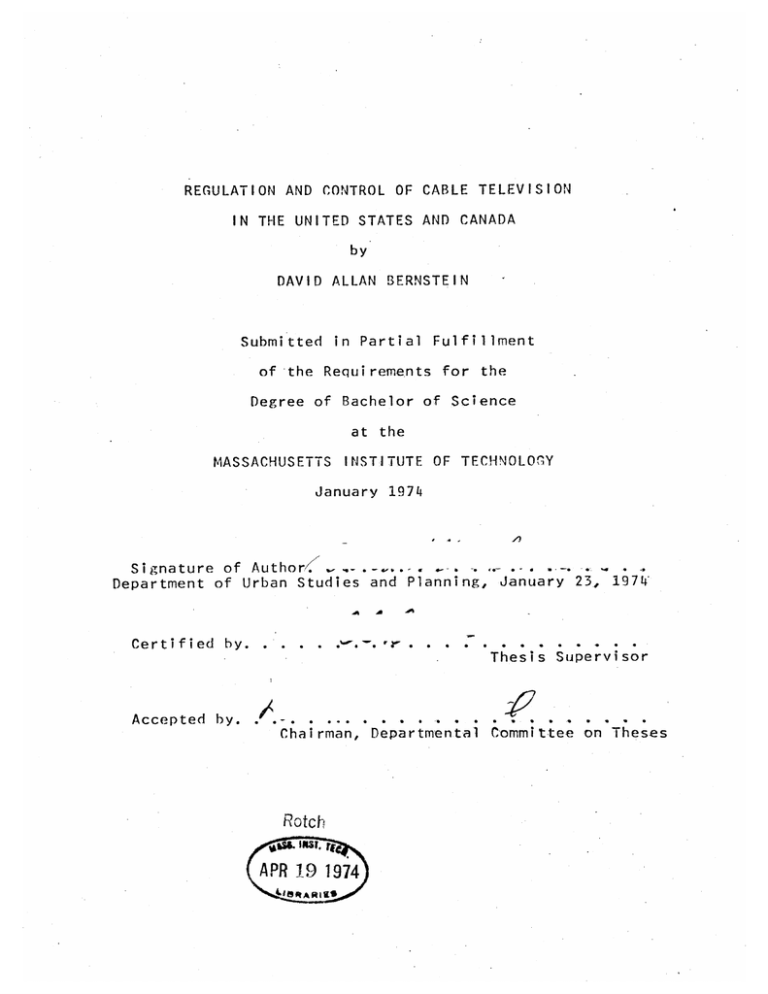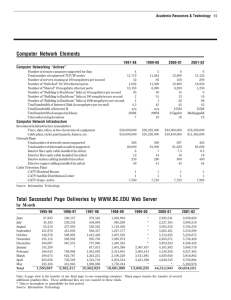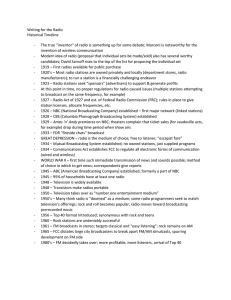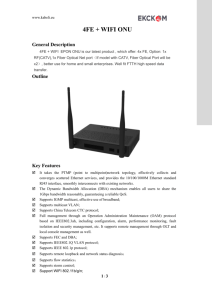REGULATION AND UNITED STATES AND CANADA IN by
advertisement

REGULATION AND CONTROL OF CABLE TELEVISION IN THE UNITED STATES AND CANADA by DAVID ALLAN BERNSTEIN Submitted in Partial Fulfillment of the Requirements for the Degree of Bachelor of Science at the MASSACHUSETTS INSTITUTE OF TECHNOLOGY January 1974 .. Signature of Author/ Department of Urban Studies and Planning, Certified by . . ..... January 23, 1974 . Thesis Supervisor Accepted by ......... Chairman, Departmental Committee on Theses Rotch APR 19 1974 'LlIStA R~I~ (2) ABSTRACT Regulation and Control of Cable Television in the United States and Canada by David Allan Bernstein Submitted to the Department of Urban Studies and Planning on January 23, 1974 in partial fulfillment of the requirements for the Degree of Bachelor of Science. In 1952 the Federal Communications Commission completed work on the allocation of television frequencies for the nation's communities. The FCC's philosophy of local service provided that there would be local television service in as many communities as possible. However, the plan went awry because of the failure of the FCC to examine the economic factors affecting small television market areas, and the dependence of this plan on the use of the UHF band. In the late 1950's the FCC first considered cable television but found it had no jurisdiction in the area. However, as the perceived impacts on the small television stations by cable were examined by the FCC, it gradually assumed greater powers over cable. The FCC's aim in regulation of cable was until very recently the protection of its 1952 allocation plan; in 1972 it declared inoperative its previous policy on cable. In Canada, the early growth of cable systems was caused in part by the lack of existing television stations and the FCC's allocation program which resulted in television stations being set up near the Canadian border to draw on the additional audience and possible advertising revenues. The major difference in the administration of cable in the United States and Canada related to the question of ownership of cable systems by telephone companies. Thesis Supervisor: Carroll Bowen (3) TABLE OF CONTENTS Introduction. . . . . . . . . . . . . . . . Introduction to United States CATV History. United States CATV History. . . . . . . . . . . Canadian CATV History . . . . . . . . . . . . . Impacts . . . . . . . . . . . . . of Regulation Appendix A: The Communications Act of 1934. .. B: The British North America Act of 1867 . C: Canadian Radio-Television Commission Policy Statement of July 16, 1971 Glossary Footnotes of . Terms . . . Bibliography. .... . . . . . . . . . . . . . . . . . . . . . . . . . . . . . . . . . . . . . . . . . .page 4 .page 6 .page .page 7 19 .page 30 .page 33 .page 34 .page 35 .page .page 37 39 .page 40 (4) INTRODUCTION A cable antenna system (CATV) receives signals of television broadcast stations and distributes them by means of a wire or cable to its subscribers. The CATV utilizes a master antenna, usually located on a high-point such as a mountain. There are two types of systems microwave * - off the air and served systems, with the latter used to bring broadcast signals over many miles. While the early systems were capable of carrying five channels, twenty and forty channel systems are now proposed or in operation. CATV service began in the late 1940's as a means of bringing needed television service to areas which lacked such service or had only one or two signals because of their remote location or terrain conditions. In the early 1960's a new kind of CATV service began - one where cable proposed to operate in major cities which have extensive television service. Here the CATV system offered something that broadcast television received off the air could not always supply: a high quality color picture. In addition, exclusive programming such as home games of local sports teams and other programming not available from broadcast stations could complement the services offered to metropolitan CATV subscribers. (5) Future developments concerning CATV include the possibility that broadcast television will be restricted to cable as its means of distribution, rather than the system of radio radiation as it is known today. The frequency spectrum vacated by commercial television might be utilized to serve the fast growing demand for mobile communications. (6) Introduction to United States CATV History In the late 1950's the Federal Communications Commission (FCC) first considered CATV and found that it had no jurisdiction to regulate CATV. However, this attitude soon began to change, first on case-by-case consideration of microwave-served CATV systems, and later by rulemaking proceedings affecting microwave-affected CATV systems. By 1966, the FCC had extended regulation to all CATV systems, and enacted stringent rules barring CATV systems from entering the top 100 television markets. A decision to halt CATV expansion in the San Diego area lead to the Southwestdrn Cable Co. v. FCC Supreme Court decision in 1968. The Court stated that "CATV systems were engaged in interstate communication and therefore were subject to regulation by the FCC under the Communications Act of 1934". The FCC's gradual entrance into CATV regulation was caused by serious doubts as to whether it had jurisdiction in this area. The FCC's aim in regulation of CATV was until very recently the protection of the local/UHF station. broadcasting This situation was caused.in part by the adoption of the "local service" philosophy by the FCC in 1952 when designing the national television frequency allocation setup. Thus although responsible for restricting CATV growth for many years, the FCC was in part responsible for the creation of CATV. (7) United States CATV History Much of the regulatory and judicial actions taken regarding CATV was based on the Communications Act of 1934 (see Appendix A). The Act basically provided for the regulation of interstate and foreign commerce in communication by radio or wire in a beefed up and centralized agency, the Federal Communications Commission. Previously, federal authority had been divided up among several agencies. The regulation of radio communications was under federal jurisdiction; as radio would usually cover more than one state, and interstate and foreign commerce was a federal right derived from the Constitution. This Act was the final assertion of control over broadcasting by the federal government. In 1952, the FCC completed work on the allocation of television frequencies for the nation's communities. They had the choice of setting up regional broadcasting markets, where a few stations would serve many small communities, or a system of small markets served by a local television station. The former would provide most viewers with a choice of a few stations, with the stations located in the largest city of the region. The latter, chosen by the FCC, would for the most part restrict the number of stations, usually one or two, that any one community could receive. (8) The FCC's philosophy of "local service" provided that there would be local television stations broadcasting in as many communities as possible, with the hope that local broadcasters would provide local service and community programming. Stations licensed before 1952 were exempted from the small market plan and were incorporated into the new system. While designing the national television frequency allocation program, it became readily apparent that there was insufficient space available in the VHF spectrum to accommodate all the television stations planned if the principle of local service with its increased frequency rairements was to be followed. Therefore the frequency spectrum comprising what is now called the ultra-high frequency was set aside for tel evision broadcasting, and new television station licences were issued both in the remaining frequencies available in the VHF band and the new UHF area. Virtually all the television licences issued in the VHF spectrum before 1952 were in large metropolitan areas because of the large size of the television viewing market. Because most of the VHF television frequencies had been allocated before 1952, most of the television stations that would be licensed in smaller markets would be assigned a UHF channel. However, a national market of VHF only television receivers had already been built up. For a few years after 1952, most of the television stations licensed (9) in the UHF band failed because of the small size of the possible viewing market capable of viewing UHF transmission on their television. Because many of the UHF stations that failed or areas in which no license application had been filed were located in the smaller communities where no television service was available, auxiliary services such as boosters and translators * were used illegally by many communities to relay the surrounding community's television station's signal beyond its normal coverage area. CATV systems, however, were more efficient than boosters in providing additional television service. Thus a large part of CATV growth in the smaller communities was a direct result of the FCC's philosophy of "local service", with its resultant dependence on the use of the UHF spectrum. Congress began its first active consideration of CATV in hearings before the Senate Committee on Interstate and Foreign Commerce in 1958. Bills were introduced in 1959 to regulate CATV, which up to this time was not regulated by federal agencies. After hearings, the Subcommittee on Communications of the Senate Interstate and Foreign Commerce Committee reported its own bill to the Senate, bill S. 2653. Following two days of debate, the bill was sent back to 'the committee. Two bills, S. 1044 and H.R. 6840, were introduced (10) in the following session of Congress at the request of the FCC, but it received no action. Before the FCC had asserted general jurisdiction over CATV, a case was brought before it that dealt with distant television signal importation on a CATV system. The Carter Mountain Transmission Corporation of Cody, Wyoming, applied for a construction permit in April 1958 for microwave radio relay facilities to pick up the broadcast signal of KTWO-TV in Casper, Wyoming, and deliver it to CATV systems in Riverton, Lander, and Thermopolis, Wyoming. Carter was already licenced to operate microwave facilities on a common-carrier basis for transmission of other television signals to CATV systems at Riverton, Lander, Worland, Basin, and Greybull, Wyoming. In April 1959, after the construction permit was granted without a hearing, the licensee of KWRB-TV of Riverton contested the application, as a objection was raised to the increased competition inherent in the importation of another signal by the local CATV. KWRB-TV claimed that the reception of the distant television station on the CATV would have a substantially adverse economic impact on KWRB-TV, and. further claimed that Carter Mountain Transmission Corporation was not eligible for common-carrier authorization. The FCC found that Carter was a bona-fide common-carrier, (11) as it was demonstrated that Carter held itself out for hire and invited the public to use its facilities. In addition, Carter and the CATV companies were found to be separate legal entities. However, the FCC subsequently denied the application by Carter, finding that the economic impact on KW.'RB-TV was of legal significance. "A grant of common-carrier radio facilities requires a finding that the public interest will be served thereby, certainly the well-being of existing TV facilities is an aspect of this public interest". Thus the FCC placed the protection of the existing broadcasting stations above the rights of the CATV operator. In line with this concept, the FCC helped lobby for legislation which resulted ultimately in the All-Channel Act. The Act banned from interstate commerce after April 1964 all television sets not capable of receiving all 82 channels (both VHF and UHF). By increasing the market capable of receiving UHF transmissions, it was hoped that UHF station licensees would become more financially stable because of increased advertising revenues resulting from a larger viewing market. It was hoped that broadcasters would be more encouraged to enter the small communities where UHF stations had been allocated but never applied for. Stemming from its decision in the Carter Mountain case, the FCC began prohibiting microwave common-carriers from transmitting signals to CATV systems unless the CATV operator abided by carriage and non-duplication conditions. (12) These requirements helped insure the financial stability of some television stations which were competing with distant stations on the local CATV system. The FCC issued its First Report and Order on CATV 2 in 1965, but concerned itself only with microwave-served CATV systems because it was unsure of its jurisdiction in non microwave-served CATV systems. The carriage and non- duplication requirement would operate only at the request of the local station, and would apply only to new or changed microwave facilities serving CATV systems. requirement would be for 15 days. The non-duplication There was no position taken on copyright matters in regards to CATV, as the FCC stated that it was beyond its jurisdiction. On April 28, 1965, H.R. 7715 was introduced at the FCC's urging. Extensive hearings were held, but no further action was taken. In 1966, H.R. 13286 was introduced at the request of the FCC, giving it broad authority to regulate all CATV systems. These hearings were concluded, and H.R. 13286 was approved by the committee, but no further action was taken on the bill. Thus in lieu of legislative action giving the FCC broad authority over CATV, the FCC issued its Second Report and Order on CATV to include all CATV systems, not just those served by microwave, "to integrate the CATV service into the national TV service to all people of the U.S., both th6se (13) who are cable viewers and those who are dependent on off-the-air service". 3 The FCC felt that the rules were "essential.to insure that CATV continues to perform its valuable supplementary role without unduly damaging or impeding the growth of the TV broadcast service".4 The non-duplication requirement was reduced from 15 to 1 day. The Major Market Distant Signal Policy was adopted in the Second Report. This policy required that "the signal of a TV broadcast station shall not be extended beyond its B contour into the top 100 markets . . . by a CATV system which has obtained a franchise for operation in such a market".5 If the importation of distant signals in the top 100 markets was not prevented, the FCC felt that CATV would undermine the development of UHF, again voicing their concept of the protection of existing broadcasting stations. The FCC had concluded that its statuatory powers included authority "to promulgate necessary and reasonable regulations to carry out the provisions of the Communication6 Act and to prevent frustration of the regulatory scheme by CATV operations, irrespective of the use of microwave".1' 6 Even systems with facilities located wholly-within one state could be considered interstate since "they form a connecting link in the chain of communication between the point of origin. . . and reception by the viewing public". 7 (14) One of the other major legislative problems concerning CATV facing the Congress was the question of whether CATV systems were governed by the existing Copyright Law, and therefore required to pay copyright royalties. A case was brought before the court in 1967 testing the liability of CATV operators under the Copyright Act to pay for broadcasted programs that they carried on their system. The Fortnightly Corporation owned and operated CATV systems in Clarksburg and Fairmont, W,!est Virginia. Artists Television, Inc., United licensed each of the five TV stations the Fortnightly CATV system carried to broadcast motion pictures whose copyrights United Artists held. United Artists sued Fortnightly for copyright infringement. The District Court judge ruled in favor of United Artists, stating that Fortnightly did not have an implied license to reproduce and distribute the copyrighted motion 8 The U.S. Court of Appeals affirmed pictures in public. this decision. 9 However, the U.S. Supreme Court reversed the lower court's decision, holding that since "CATV systems do not in fact broadcast or rebroadcast. . . the petitioner did not under the law 'perform' the copyrighted works".10 Thus the Supreme Court ruled that CATV systems are not liable under the present Copyright Act to pay for copyrighted broadcasted programs they carry on their system. (15) After the FCC had issued its Second Report and Order on CATV, a case ultimately brought before the U.S. Supreme Court upheld the right claimed by the FCC to regulate all CATV systems, including non-microwave systems. The San Diego area had stations representing all three major networks and one independent UHF station. There were five CATV systems operating in the San Diego metropolitan area. In addition, the San Diego area was barely within the B contours of the Los Angeles stations. Midwest Television, Inc., licensee of KFMB-TV (CBS), petitioned the FCC to limit the CATV systems to serving the areas they had on record as of February 1966, effectively restricting any further expansion. Midwest claimed that the CATV systems threatened the existence of the UHF station in the San Diego area. However, the petition was denied, and Southwestern Cable Company and the other four CATV systems were allowed to continue their expansion. On a subsequent appeal to the FCC, the Commission reversed its examiner's decision, deciding that there would be a significant loss of potential audience for the independent UHF station in San Diego if CATV growth was not restricted. After the reversal, there was a change of ownership of two of the CATV systems, and Midwest Cable and the new licensee of the independent UHF station filed a petition (16) to reopen the case, in order to place additional restrictions on the CATV systems. After the petition to reopen the case was denied-by the FCC, the U.S. Court of Appeals for the Ninth Circuit held that the FCC had insufficient authority under the Communications Act to issue its ruling. However, the U.S. Supreme Court ruled that the Commission had authority to regulate CATV, but was restricted to those matters affecting the FCC's responsibility for the regulation of television broadcasting. 1 2 A major policy decision was evident in the FCC's Section 214 Decision, which ultimately resulted in the extensive slowdown in the role the telephone companies would play as connecting carriers to CATV systems. On April 6, 1966, under the Section 214 D.ecision, the FCC ordered all common-carriers to file tariffs for local distribution channels intended for use by CATV systems, asserting that the interstate character of the signal used by CATV systems "is controlling with respect to the statuatory requirement that tariffs be filed with the Commission under Section 203 of the Communications Act". 13 One of the tariffs filed under this order concerned whether carriers claiming to be connecting carriers under the Communications Act are subject to the certificate requirements expressed in Section 214 when they furnish channels of communication to CATV systems. The FCC ruled (17) that the local distribution system that telephone companies lease to CATV systems is interstate communication and thus under FCC jurisdiction, and therefore connecting carriers are not exempt from Section 214's requirement for certification and filing of tariffs. This decision extended the FCC's regulation to telephone companies involved in providing connecting carrier service to CATV systems. In 1969, the FCC Notice of Proposed Rulemaking effectively held up all applications filed under Section 214 by telephone companies desiring certification of common-carrier facilities to serve CATV systems. 14 The Commission was concerned with the implications of ownership ties between telephone companies and CATV systems. After that decision was upheld by the U.S. Court of Appeals, the U.S. Supreme Court declined to review the case. There was a change in the FCC's attitude toward CATV as expressed in the Interim Rules of 1968. The statement of purpose, "to explore the broad question of how best to obtain, consistent with the public interest standard of the Communications Act, the full benefit of developing communications technology to the public, with particular immediate reference to CATV technology and potential services, and the nature of any regulations and/or proposed legislation that may be necessary or desirable to further this goal".15 The FCC henceforth would require program origination, and also allow advertising on CATV systems. (18) The FCC made formal its new policy with regards to 16 CATV in 1972. The FCC rejected its long established philosophy that CATV was a threat to UHF development and was to be barred from the 100 top television markets. The FCC would require 20 channel capacity from all new CATV systems. In addition, CATV operators would have to provide a non-commercial public-access channel without charge on a first-come first-served basis at all times. Two additi6nal non-charge channels would have to be provided for educational and government use, in addition to program origination previously required. The FCC would continue to allow local communities to award franchises, but all such selections would also have to receive FCC certification. (19) Canadian CATV History The British North America Act of 1867 outlined the federal responsibility as regards to interprovincial communication (see Appendix B). Telegraph and other forms of communication not envisaged in the Act were to be in the exclusive domain of the federal government. The exclusive federal jurisdiction in the field of broadcasting, as a form of radiocommunication, was confirmed by the 1932 Privy Council decision in the Radio Reference case upholding a judgement of the Supreme Court of Canada. Their Lordships concluded, in that case, that broadcasting is an indivisible undertaking which requires reception as well as transmission, and which is not complete until the signals have reached the ears of those persons for whom they are intended. The Canadian Radio Broadcasting Act of 1932 gave power to the Minister of Transport to "regulate and control broadcasting in Canada" and "to carry on the business of broadcasting in Canada". At this very early datet, radio receiving apparatus, of which CATV is an extension, would have to be registered. with the Minister of Transport, and a license for its operation obtained. This is in marked contrast to the federal role of broadcasting in the United States, where federal jurisdiction over receiving apparata was never clearly taken. (20) The first CATV system in Canada commenced operations in 1952 in London, Ontario. A similar system began in Montreal in 1949, where a closed circuit system was started by Redifussion, Inc., according to a plan which had proved successful in the United Kingdom. Regulation of CATV until 1968- was under the jurisdiction of the Department of Transport (D.O.T.), which had additional responsibility for telegraph, railways, and other works in which federal jurisdiction was specified in the B.N.A. Act. The D.O.T. was primarily interested in laying down technical standards for CATV systems, however they were concerned with preserving the idea of local service, and required head-ends' of CATV systems to be within 10 miles of the area served, and virtually prohibited the use of microwave by CATV systems. Although the D.O.T. did not grant exclusive licenses for any given area, because Canadian telephone companies would generally not install more than one system in a given area at any one time, a de facto exclusivity of CATV licenses emerged. The Broadcasting Act of 1968 expressed the concept that CATV is a part of the Canadian broadcasting system, a concept disputed by the Canadian Cable Television Association. The Act also created the Canadian Radio- Television Commission (CRTC), and transferred to it.the (21) power of licensing broadcasting stations, formerly held by the Board of Broadcast Governors, and gave it new powers in regards to -licensing CATV, formerly held by the D.O.T. The CRTC held extensive hearings across Canada, and issued guidelines to- CATV systems. At the hearing on May 13, 1969, the CRTC required CATV systems to follow an order of precedence in the type and location of stations they carried. Canadian Broadcasting Corporation (CBC) government operated stations in English and French would have highest priority, followed by private Canadian networks, independent Canadian TV stations, local and educational programming, and finally non-Canadian television stations. The CRTC encouraged local programming on CATV, prohibited the alteration of programming of broadcast stations received, and prohibited the addition of any commercial messages by the CATV system. It issued exclusive licenses for the first time, and prohibited networks in the normal broadcasting sense of the word; however, would consider the linking of adjacent CATV undertakings for the purpose of distributing locally-produced programs. The CRTC, as the issuer of a CATV license, would have to approve the rate structure of the CATV operator. At the hearing beginning December 3, 1969, the CRTC held that it would not license CATV systems based on the use.of microwave or other technical systems, for the wholesale importation of programs from distant U.S. stations and (22) thereby the enlargement of the Canadian audience and market areas of U.S. networks and stations. The majority of Canadian citizens live in the major cities located in a thin strip within 100 miles of the U.S.-Canada border. In many cases they are able, with the use of outdoor antennas, to receive broadcasts from American stations located near the border. CATV systems in these areas receive broadcasts from American stations located just across the border, without the use, in most cases, of microwave links. Thus the salability of CATV in these cities is quite high as superior reception of American stations is provided without the use of large outdoor antennas. Because Canadian television broadcasting got off to a slower-start as compared to the United States, for many years the only television reception availabl.e in Canada was from American stations located near the border. CATV got its early start providing superior reception of American stations. CATV began in the major Canadian cities, as compared with the United States where penetration in major cities was prohibited by the FCC, and where smaller outlying communities provided the growth of CATV. In both cases CATV provided the viewer with the greater diversity of programming he desired, against the government's policy of allocation of television service. The ironic side-effect of the FCC's 1952 policy (23) of local service, and its reliance on hundreds of smaller community based television stations, was the effect it had on a non-existent CATV industry in Canada. If the FCC had opted for the regional service alternative, with several stations located in the largest city of the region, then for the most part, Canadians living in the major cities located near the border would not be able to receive the broadcasts, because of the greater distance between the major U.S. regional cities and the existing transmitter sites of the border television stations. The major reason for CATV in the cities of Canada was the reception of American stations, and. thus the prospect of an extensive CATV system in Canada would have been greatly diminished. Canada's population, being approximately one-tenth that of the United States population, could not economically support three networks as exists in the United States today. CATV SYSTEMS IN THE THREE LARGEST CANADIAN MONTREAL 1960 1968 K(thousands) # systems 7 5 723 527 # households 100 # subscribers 40 13.9 % penetration 7.6 source: TORONTO 1968 1960 1 9 631 482 1 47 7.5 0.2 CITIES VANCOUVER 1968 1960 2 7 291 220 114 10 4.5 39.2 Canadian Cable Television Association (24) Because of the extensive penetration of cable in the largest Canadian cities, local broadcasting stations must compete with American network outlets available on CATV. In cities like Vancouver, with nearly 40% penetration by CATV, there are serious economic effects on advertising revenue that the local station must contend with. effects are threefold. These The most serious effect is a loss of potential audience, thus limiting the amount that a local station may charge for its advertising time. Many businesses in the Vancouver area advertise on the American channels, aiming their messages to the Vancouver viewers. This is a direct loss of revenue to the local broadcasting outlet. The third effect is called the spillover problem, in which Canadian subsidiaries of American corporations do not place as much television advertising as they normally would if it was not for the fact that similar advertising campaigns placed on American television networks by their parent corporations reach a significant audience in Canada. Again it is ironic that Canada, through some of its businesses which place advertising on American television stations located near the border, should help subsidize and in some cases mean the difference betweensuccess and failure of the border stations located in the United States. Thus Canada, which can attribute much of its CATV growth to the FCC policy of local service, is in effect helping maintain the policy that has resulted in serious problems for Canadian television stations. (25) Thus the main reason for the December 3, 1969 decision on the total ban of microwave CATV systems was to stop the importation of American stations by CATV systems in areas not normally able to receive these broadcasts, even with the use of outdoor antennas. Because of the rapid growth of CATV systems, especially those using microwave to import signals hundreds of miles the CRTC felt it imperitive to limit the accessibility of American television to those who were able to receive it normally with the use of an outdoor antenna, as it would be extremely difficult for the Commission to require compliance by CATV operators after the public had become accustomed.to the American stations. In the April 10, 1970 hearing, the CRTC held that duplication of programming by American stations broadcast over CA.TV would be blacked. out whenever a Canadian station was broadcasting the same programming at the same time. The Commission's most far-reaching decision, however concerned non-carriage of American stations under specific circumstances. "Applicants should bear in mind that if a TV station solicits Canadian advertising outside of his market or licensed area so as to disrupt the economic balance established by the normal licensing practice, the Commission may refuse to authorize the distribution of its programs by a CATV system". dropped from the CATV system, If an American channel was the viewer would still have (26) the opportunity to receive the broadcasts by putting up an outside antenna. Clearly this is an area in which the CRTC would have to tread very carefully. The CRTC considered three policy alternatives on the future of CATV in Canada in its July 16, 1971 policy statement. The first dealt with the unfettered growth of CATV and the consequential diminishing of the ability of television stations to serve the public. The second dealt with the creation of conditions that would result in the restriction, halting or even rolling back of~ the development of CATV in the interest of safeguarding the television stations. Both alternatives were rejected, and the CRTC decided instead to develop a policy which would integrate CATV into the Canadian broadcasting system while avoid disrupting the existing broadcasting system (see Appendix C). A policy of vigorous development of CATV and of the whole broadcasting system was to be followed. The CRTC ruled on the question of copyright royalties for televi-sion broadcasting stations that supply CATV systems with copyrighted material, stating that "television stations are the suppliers, and cable television systems are the users. Thus the basic principle involved is: one should pay for what he uses to operate his business". However, although suggesting several alternative proposals, the CRTC failed to issue a definitive ruling in the area. (27) A novel proposal being examined by the Commission related to the deletion and substitution of commercials on American stations rebroadcast over Canadian CATV systems. This would severely curtail any advertising on American stations placed by Canadian companies. Substitution of local station commercial messages would then increase the size of the market viewing Canadian commercial messages. The Commission did not require all.CATV systems to delete commercial messages in signals they distribute because it would be financially impossible for all but a few systems. However, the CRTC withdrew its requirement that received television signals should not be altered, and. permitted the removal by CATV licensees of the commercial value contained in the signals of stations not licensed to serve Canada. "While cable television licensees will,not be permitted to sell replacement commercial messages themselves, they will be encouraged to make contractual arrangements with Canadian television stations in their areas to insert replacement signals carrying commercial messages sold by the Canadian television stations". Thus CATV may eventually become the savior, rather than the death-knell to those stations located near the border that compete extensively with American stations for the Canadian viewing market. The CRTC examined the impact that master-antenna television systems in apartment buildings was having on both the CATV systems and local broadcasters,.but did not (28) emerge with any rulings. However, the CRTC clearly has the authority to regulate and control this expanding area, a area over which the FCC has no jurisdiction. Canadian CATV systems do not pay royalties to local municipalities as their counterparts do in the United States, however, rate structures proposed by CATV systems are examined by the CRTC, and provision is made for -flexibility in. the rate structure for CATV systems that would buy additional Canadian programs and originate extensive local programming. The role of the telephone companies in CATV ownership and operation is more complicated than in the United States. There are several major Canadian telephone companies, each with exclusive rights over one or more provinces. Some are privately owned, while others in Western Canada are owned by the provincial government. Alberta Gove.rnment Telephones is the only licensed CATV operator in that province, and the provincial government strongly supports the' integration of the two services by the government monopoly, feeling that cost savings are realized by the non-duplication of CATV (cable) and telephone lines. In provinces where the telephone company is privately owned, the CATV systems are also privately owned. In many cases the telephone companies own extensive parts of CATV plants, as definitive rulings have not yet emerged on what role the telephone (29) companies should play with regard to CATV. Contractual arrangements range from total ownership of the distribution system by the CATV operator to the so-called partial systems, which are commoner, where ownership and effective control of the coaxial cable are retained by the telephone company, while the antenna, the amplifiers that relay the signal and the connections to each household are the property of the CATV operator. About 70O of the cables used by CATV systems are leased from the local telephone companies under agreements which often prohibit the CATV operators from offering other telecommunications services that they might be able to provide by modifying their systems. 1 7 The telephone companies are regulated on the federal level by the Canadian Transport Commission, and thus possible CRTC rulings on ownership as regards to telephone companies could not be definitive. Accordingly, the federal government outlined its proposal for a single federal agency for telecommunications including broadcasting, in order that more effective regulation of telecommunications carriers subject to federal authority be followed. 18 (30) Impacts of Regulation In the United States the FCC's aim in regulation in CATV was until very recently the protection of the local community television station and the UHF television broadcasting station. It was pointed out that the FCC was in part responsible for the early growth of.CATV in the United States, because of the failure of the 1952 television allocation program to recognize the economic hardships that broadcasters in smaller communities would ultimately face, especially if saddled with ,a UHF frequency. Placing restrictions on the growth of CATV in the smaller communities failed to alter significantly the basic problems facing the broadcasters in those communities; however, it placed unnecessary restrictions on the growth of CATV in those areas. The FCC freeze on CATV expansion in the top 100 television markets has prevented the citizens of the nation's largest cities from utilizing one of the most promising of technical innovations. In Canada, the early growth of CATV systems in the major metropolitan areas was caused in part by the lack of existing television stations and the FCC policy of local service' so that small border communities could broadcast to CATV systems located in Canada instead of the regional approach to frequency allocation, which because of increased (31) distance between regional American cities and Canadian CATV head-ends would have resulted in a greatly diminished CATV system in Canada. CATV had established itself as a major factor in many Canadian cities before general policy decisions were taken by the government. Recognizing its nature and future possibilities, the CRTC encouraged the controlled growth of CATV in the Canadian broadcasting system. A program relating to the deletion and substitution of commercials on American stations rebroadcast over Canadian CATV systems offers the possibility that CATV may ultimately be responsible for the increased financial stability of Canadian television stations. The major difference in the administration of CATV in the United States and Canada relates to the question of ownership. In the United States telephone companies are severely restricted from owning CATV concerns or leasing the cables to independent CATV operators. This results in a much higher initial cost to the CATV operator, as he must purchase the complete plant including cable, rather than lease it from the telephone company and pay an annnual fee. The need for greater financial stability and backing of CATV operators is perhaps responsible for smaller companies deserting the industry because of insufficient funding. The impact on the American consumer is unclear - competition for telecommunication services in future between (32) a CATV common-carrier and telephone companies may help to keep the cost of services provided down; however, duplication of facilities may tend to raise costs of both CATV and telephone companies over what it might have been if duplication was not prevalent. In Canada there are no restrictions regarding CATV ownership by telephone companies. As some provincial telephone companies are nationalized, the lack of duplication between two government agencies, the telephone company and the CATV common-carrier, results in a net saving to the tax-payer. In other areas of privately owned telephone companies, it provides flexibility to these companies to use the newest technology to improve service in standard areas and new growth area. The lower initial costs to CATV systems in Canada which lease cable from the telephone company must be evaluated on the other hand by the lack of future revenues derived from the new services the cable can provide, but would accrue to the telephone companies as the common-carrier. (33) APPENDIX A: THE CONMUNICATIONS ACT OF 1934 "For the purpose of regulating interstate and foreign commerce in communication by wire and radio so as to make available, so far as possible, to all the people of the United States a rapid, efficient, nation-wide, and world-wide wire and radio communications service with adequate facilities at reasonable charges for the purpose of the national defence, for the purpose of promoting safety of life and property through the use of wire and radio communication, and for the purpose of securing a more effective execution of this policy by centralizing authority heretofore granted by law to several agencies and by granting additional authority with respect to interstate and foreign commerce in wire and radio communication, there is hereby created a commission to be known as the "Federal Communications Commission", which shall be constituted as hereinafter provided, and which shall execute and enforce the provisions of this Act." (34) APPENDIX B: THE BRITISH NORTH AMERICA ACT OF 1867 Exempted from exclusive provincial jurisdiction over "local works and undertakings" was "lines of steam and other Ships, Railways, Canals, Telegraphs and other 'orks and Undertakings connecting the Province with any other or others of the Provinces, or extending beyond the limits of the Province". "Such works as, although wholly situate within the Province, are before or after their execution declared by the Parliament of Canada to be for the General Advantage of Canada or for the advantage of two or more of the Provinces". "It shall be lawful for the Queen, by and with the Advice and Consent of the Senate and House of Commons, to make laws for the Peace, Order and Good Government of Canada, in relation to all matters not coming within the Classes of Subjects by this Act assigned exclusively to the legislatures of the Provinces". (35) APPENDIX C: CANADIAN RADIO-TELEVISION COMMISSION POLICY STATEELIJNT OF JULY 16, 1971 "A third possibility is the attempt to develop a policy which would integrate cable television into the Canadian broadcasting system, avoid disrupting the system, enhance the capacity of the system to produce programs, and finally to permit a vigorous development of cable television and of the whole Canadian broadcasting system." "After much study and consultation, it is this position that the Commission favours". "The danger to the Canadian broadcasting system is real and immediate. The Commission reiterates that the Canadian broadcasting system must improve if it is to survive as a system. Improvements may be fruitlesshowever, unless difficulties in the system are resolved realistically." "In raising these issues the Commission emphasizes that the purpose is not to safeguard vested interest or to maintain a technology that would have outlived its usefulness. The purpose and mandate of the Commission is to uphold the public interest and to safeguard the system which, in the considered opinion of the Commission, provides the best service for the largest number of Canadians." "The Commission has indicated in previous policy (36) announcements how unlimited penetration by United States stations on a wholesale north to south basis would completely destroy the licensing logic of the Canadian broadcasting system as established by the Broadcasting Act. If a solution is not found to integrate cable into the overall system, the impact, by fraturing the economic basis of the private broadcasters, would also disrupt the Canadian cultural, educational and information imperitives of both the public and private sectors of the Canadian broadcasting system." "At stake is more than a system of national communication, because broadcasting also has the vitally important task of identifying and strengthening cultural entities, regional entities and community loyalties. As the public body charged with responsibility of maintaining and strengthening the Canadian broadcasting system, the Canadian Radio-Television Commission, in stating the problems of the situation, is convinced that a solution must be found if the Canadian broadcasting system is to survive." (37) GLOSSARY OF TERMS A & B Contours - the television engineer's determination of television signal quality. The A contour comprises the area surrounding the transmitter for many miles, in which the highest quality signal may be received without an outdoor antenna. The B contour, which encloses the A contour, represents the area in which poorer quality signals are received, even with the aid of an outdoor antenna. Boosters and translators - devices that amplify and retransmit broadcasted signals of television stations. These are used primarily in areas where signal quality is degraded because of physical interference, such as mountains or large buildings. Carriage - the inclusion of a television station's signal on a CATV system. When CATV systems were limited to five channels, often they would include distant stations and not carry local stations, thus cutting off these stations from access to the CATV subscibers. With increased CATV channel carrying capabilities, this problem is no longer as critical as it once was. r- . - (38) Common carrier - an organization or company that provides services for public hire. They are characterized by a tendancy toward monopoly situations. The telephone company is an example of a common carrier. Head-end - the large master antenna used by CATV systems to receive broadcasts from distant stations. The antenna is usually located on a high point, such as a mountain, so that the highest quality signal may be received. Microwave - a system whereby signals can be rebroadcast over CATV from hundreds of miles away. Parabolic discs mounted on towers located miles apart send a signal along the route connecting the towers. It is much cheaper to rent or lease a microwave link than to lay a cable.. Non-duplication - a procedure whereby a CATV system will not carry a program of a distant television station if that program is also carried on that day by a local television station. UHF - ultra-high frequency (channels 14-83). VHF - very-high frequency (channels 2-13). (39) FOOTNOTES 1. FCC Docket 12443. 2. First Report and Order on CATV, 38 FCC 683 (1965). 3. Second Report and Order on CATV, 2 FCC 2d 725 (1966). 4. Ibid. 5. Ibid. 6. Ibid. 7. Ibid. 8. U.S. District Court, 255 F. Supp. 177, 7 RR 2d. 2099 (1966). 9. U.S. Court of Appeals, 377 F. 2d 872, 7 RR 2d 2099 (1967). 10. U.S. Supreme Court, 932 U.S. 390. 11. FCC Docket 16786. 12. U.S. Supreme Court, 13 RR 2d 2045, 390 U.S. 157 (1968). 13. FCC Dock'.et 17333. 14. FCC Docket 18509. 15. FCC Docket 18397. 16. Cable Television Service- FCC Rules & Regulations, Feb. 1972. 17. Proposals for a Communications Policy for Canada, Government of Canada publication, 1973. 18. Ibid. (40) BIBLICGRAPHY 1. Government of Canada Canadian Radio-Television Commission Cable Television in Canada, Jan. 1971. The Integration of Cable Television in the Canadian Broadcasting System, Feb. 26, 1971. Transcript of Public Hearings on CATV, Montreal, beginning April 26, 1971. Canadian Broadcasting "A Single System" Policy statement on cable television, July 16, 1971. Department of Communications An Analysis of the Constitutional and Legal Basis for the Regulation of Telecornmunications in Canada, Telecommission Study 1(a), Ottawa 1971. History of Regulation and Current Regulatory Setting, Telecommission Study 1(b), Ottawa 1971. Analysis of the Relationshins Between the Functions of the Common-carriers and those Engaged in Broadcasting, Telecommission Study 1(d), Ottawa 1971. Relevance of Regulatory Exnerience in Countries other than Canada, Telecommission .Study 1(f), Ottawa 1971. Re-aprraisal of the Present Management of the Radio Spectrum, Telecommission Study 2(h), Ottawa 1971. Multiservice Cable Telecomm'nication Systems The Wired City, Telecommission Study 8(d), Ottawa 1971. Proposals for a Communications Policy for Canada, A position paper of the Government of Canada, Hon. Gerard Pelletier, Minister of Communications, March 1973. (41) 2. United States Government House of Representatives Committee on Interstate and Foreign Commerce Regulation of Community Antenna Television, Hearings on bills H.R. 12914, H.R. 13286, H.R. 14201, March 1966. Subcommittee on Communications and Power Regulation of Community Antenna Television, Hearings on bill- H.R. 7715, May 1965. Regulation of Community Antenna Television Systems, Hearings on bills H.R. 10268, H.R. 10510, May.1969. 3. Sloan Commission on Cable Communications, On the Cable - The Television of Abundance, McGraw-Hill Book Company, 1971.







